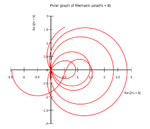Kynophile
ZooVille Philanthropist
Counting to 1,000 has reawakened the math nerd in me, so this is a thread for sharing obscure, arcane knowledge, regardless of zooeyness. So, allow me to present: the Riemann zeta function!

This is a function on complex numbers, z, defined by Zeta(z) = (1/1^z)+(1/2^z)+(1/3^z)+...+(1/n^z) extended for all natural numbers n. Because of the way complex numbers work with exponents, this converges to a single, defined value whenever the real part of z is greater than one. But for other values of z, there are mathematical tools to extend the definition to make sense for any z except 1, which makes it blow up to infinity.
This is of interest to mathematicians because it can be expressed another way, as Zeta(z) = 1/(1-2^-z)*1/(1-3^-z)*1/(1-5^-z)*...*1/(1-p^-z) for all prime numbers p. So if we understand this function, we understand how prime numbers are distributed, which has implications in physics and probability theory.
One of the questions about this function is where it equals zero, meaning where does everything in this sum cancel out, and there is apparently a pattern to them. The function has two kinds of zeros. One kind is the trivial zeros, when z is a negative even number, because of the way the definition is extended, meaning in that sense we can say that 1+4+9+16+...+n^2+...=0, in this sense, which is bizarre enough. But then there are the nontrivial zeros, all of which we've found so far have a real part equal to 1/2. The above graph is a trace of the values of this function for z=1/2+it, for t=0 through 34.
Even though we've found no zeros outside of this range (and this has been tested for a humongous range of values for z), mathematicians can't take it as true that there aren't any. Proving or disproving that all of the nontrivial zeros have real part 1/2 is called the Riemann hypothesis, a problem that hasn't been solved in a hundred years of effort, and for which there is a prize of a million dollars for anyone who does either one rigorously. If it's true, it would imply that the prime numbers, for all their appearance of randomness, are very tightly bound in distribution to a much simpler looking function, the logarithmic integral.
So, what does this matter? Who knows? No one had any use for number theory until computers made cryptography a good tool. But I'm amused by the idea that Zeta is so tied to the building blocks of the natural numbers, that they give the whole thing its best possible order even amid seemingly random occurrences. That halfway between nothing and identity lies balance in this infinite product, and that such balance exists infinitely into the imaginary.
So, consider this a dorky miniature lecture hall. Talk about anything, especially if almost no one here would understand it and no one on Earth understands it completely. Ask questions, share passions of the intellect, and simply be yourself, no matter how insane it is to anyone else.

This is a function on complex numbers, z, defined by Zeta(z) = (1/1^z)+(1/2^z)+(1/3^z)+...+(1/n^z) extended for all natural numbers n. Because of the way complex numbers work with exponents, this converges to a single, defined value whenever the real part of z is greater than one. But for other values of z, there are mathematical tools to extend the definition to make sense for any z except 1, which makes it blow up to infinity.
This is of interest to mathematicians because it can be expressed another way, as Zeta(z) = 1/(1-2^-z)*1/(1-3^-z)*1/(1-5^-z)*...*1/(1-p^-z) for all prime numbers p. So if we understand this function, we understand how prime numbers are distributed, which has implications in physics and probability theory.
One of the questions about this function is where it equals zero, meaning where does everything in this sum cancel out, and there is apparently a pattern to them. The function has two kinds of zeros. One kind is the trivial zeros, when z is a negative even number, because of the way the definition is extended, meaning in that sense we can say that 1+4+9+16+...+n^2+...=0, in this sense, which is bizarre enough. But then there are the nontrivial zeros, all of which we've found so far have a real part equal to 1/2. The above graph is a trace of the values of this function for z=1/2+it, for t=0 through 34.
Even though we've found no zeros outside of this range (and this has been tested for a humongous range of values for z), mathematicians can't take it as true that there aren't any. Proving or disproving that all of the nontrivial zeros have real part 1/2 is called the Riemann hypothesis, a problem that hasn't been solved in a hundred years of effort, and for which there is a prize of a million dollars for anyone who does either one rigorously. If it's true, it would imply that the prime numbers, for all their appearance of randomness, are very tightly bound in distribution to a much simpler looking function, the logarithmic integral.
So, what does this matter? Who knows? No one had any use for number theory until computers made cryptography a good tool. But I'm amused by the idea that Zeta is so tied to the building blocks of the natural numbers, that they give the whole thing its best possible order even amid seemingly random occurrences. That halfway between nothing and identity lies balance in this infinite product, and that such balance exists infinitely into the imaginary.
So, consider this a dorky miniature lecture hall. Talk about anything, especially if almost no one here would understand it and no one on Earth understands it completely. Ask questions, share passions of the intellect, and simply be yourself, no matter how insane it is to anyone else.

